50th March on Washington for Jobs and Freedom 2013
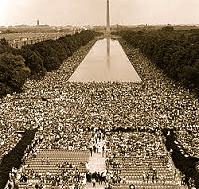
The March on Washington 1963
1963 ARC Identifier 49737 / Local Identifier 306.3394. Scenes from Civil Rights March in Washington, D.C., August 1963. People walking up sidewalk; gathering on Mall, standing, singing. Lincoln Memorial, Washington Monument, crowd gathered on the Mall. People marching with signs, many men wearing UAW hats. People at speakers podium, men with guitars. Crowds outside of the White House, sign: The Catholic University of America. Band, people marching down street. Many signs, including All D.C. wants to vote! Home Rule for DC; Alpha Phi Alpha; and Woodstock Catholic Seminary for Equal Rights. Lincoln Memorial with crowds gathered around reflecting pool. People singing and clapping at speakers platform. Signs, people clapping. Man speaking, woman playing guitar and singing at podium. More speakers and shots of the crowd. A chorus, NAACP men in crowd. Close-ups of people in crowd with bowed heads. Shots taken from above of White House. More speakers, including Rev. Martin Luther King, Jr. Women at podium singing We Shall Overcome. Crowd swaying, singing, holding hands. U.S. Information Agency. (1982 – 10/01/1999) Made possible by a donation from Public.Resource.Org.
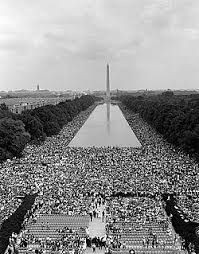 View from the Lincoln Memorial toward the Washington Monument on August 28, 1963
View from the Lincoln Memorial toward the Washington Monument on August 28, 1963
The March on Washington for Jobs and Freedom or “The Great March on Washington“, as styled in a sound recording released after the event, was one of the largest political rallies for human rights in United States history and called for civil and economic rights for African Americans. It took place in Washington, D.C. on Wednesday, August 28, 1963. Martin Luther King, Jr., standing in front of the Lincoln Memorial, delivered his historic “I Have a Dream” speech advocating racial harmony during the march.
The march was organized by a group of civil rights, labor, and religious organizations, under the theme “jobs, and freedom.” Estimates of the number of participants varied from 200,000 to 300,000. Observers estimated that 75–80% of the marchers were black and the rest were non-black
The march is widely credited with helping to pass the Civil Rights Act (1964) and the Voting Rights Act (1965).
Background and organization
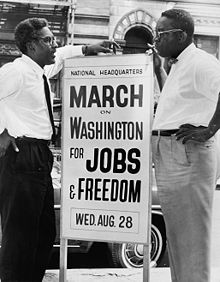 Bayard Rustin (left) and Cleveland Robinson (right), organizers of the March, on August 7, 1963
Bayard Rustin (left) and Cleveland Robinson (right), organizers of the March, on August 7, 1963
The impetus for a march on Washington developed over time, and earlier efforts to organize such a demonstration included the March on Washington Movement of the 1940’s. The threat of the earlier march had convinced President Roosevelt to establish the Committee on Fair Employment Practice and ban discriminatory hiring in the defense industry.
A. Philip Randolph, the president of the Brotherhood of Sleeping Car Porters, president of the Negro American Labor Council, and vice president of the AFL-CIO was a key organizer. The 1963 march was an important part of the rapidly expanding Civil Rights Movement. It also marked the 100th anniversary of the signing of the Emancipation Proclamation by Abraham Lincoln.
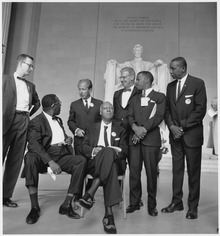 Civil Rights March on Washington, D.C. (Leaders of the march)
Civil Rights March on Washington, D.C. (Leaders of the march)
This march was planned by the Council for United Civil Rights Leadership, an umbrella organization created in June 1963. This coalition, whose leaders became known as the “Big Six“, included: Randolph who was chosen as the titular head of the march, James Farmer(president of the Congress of Racial Equality), John Lewis (chairman of the Student Nonviolent Coordinating Committee), Martin Luther King, Jr. (president of the Southern Christian Leadership Conference), Roy Wilkins (president of the NAACP), and Whitney Young (president of the National Urban League).
The mobilization and logistics of the actual march itself was administered by deputy director Bayard Rustin, a civil rights veteran and organizer of the 1947 Journey of Reconciliation, the first of the Freedom Rides to test the Supreme Court ruling that banned racial discrimination in interstate travel. Rustin was a long-time associate of both Randolph and Dr. King. With Randolph concentrating on building the march’s political coalition, Rustin built and led the team of two hundred activists and organizers who publicized the march and recruited the marchers, coordinated the buses and trains, provided the marshals, and set up and administered all of the logistic details of a mass march in the nation’s capital. During the days leading up to the march, these 200 volunteers used the ballroom of Washington DC radio station WUST as their operations headquarters.
The march was not universally supported among civil rights activists. Some, including Rustin (who assembled 4,000 volunteer marshals from New York), were concerned that it might turn violent, which could undermine pending legislation and damage the international image of the movement. The march was condemned by Malcolm X, estranged spokesperson for the Nation of Islam, who termed it the “farce on Washington.”
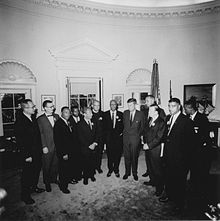 President Kennedy meets with leaders of March on Washington 8-28-63
President Kennedy meets with leaders of March on Washington 8-28-63
March organizers themselves disagreed over the purpose of the march. The NAACP and Urban League saw it as a gesture of support for a civil rights bill that had been introduced by the Kennedy Administration. Randolph, King, and the Southern Christian Leadership Conference (SCLC) saw it as a way of raising both civil rights and economic issues to national attention beyond the Kennedy bill. Student Nonviolent Coordinating Committee (SNCC) and Congress of Racial Equality (CORE) saw it as a way of challenging and condemning the Kennedy administration’s inaction and lack of support for civil rights for African Americans.
Despite their disagreements, the group came together on a set of goals:
- Passage of meaningful civil rights legislation.
- Immediate elimination of school segregation.
- A program of public works, including job training, for the unemployed.
- A Federal law prohibiting discrimination in public or private hiring.
- A $2-an-hour minimum wage nationwide.
- Withholding Federal funds from programs that tolerate discrimination.
- Enforcement of the 14th Amendment to the Constitution by reducing congressional representation from States that disenfranchise citizens.
- A broadened Fair Labor Standards Act to currently excluded employment areas.
- Authority for the Attorney General to institute injunctive suits when constitutional rights are violated.
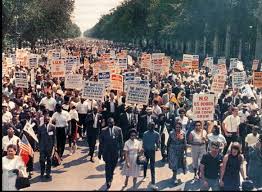 Marchers converge on Washington D.C.
Marchers converge on Washington D.C.
Traveling by road, rail, and air, from literally near and far, thousands arrived in Washington D.C. on Wednesday, August 28. Marchers from Boston traveled overnight and arrived in Washington at 7am after an eight-hour trip, but others took much longer bus rides from places like Milwaukee, Little Rock, and St. Louis. The New York City bus terminal was busy throughout the night with crowds similar and even larger than what would be expected on the eve of a holiday. Maryland police reported that “by 8:00 a.m., 100 buses an hour were streaming through the Baltimore Harbor Tunnel.”
One reporter, Fred Powledge, accompanied African-Americans who boarded six buses in Birmingham, Alabama for the 750-mile trip to Washington. The New York Times carried his report:
“The 260 demonstrators, of all ages, carried picnic baskets, water jugs, Bibles and a major weapon – their willingness to march, sing and pray in protest against discrimination. They gathered early this morning [August 27] in Birmingham’sKelly Ingram Park, where state troopers once [four months previous in May] used fire hoses and dog to put down their demonstrations. It was peaceful in the Birmingham park as the marchers waited for the buses. The police, now part of a moderate city power structure, directed traffic around the square and did not interfere with the gathering… An old man commented on the 20-hour ride, which was bound to be less than comfortable: “You forget we Negroes have been riding buses all our lives. We don’t have the money to fly in airplanes.”
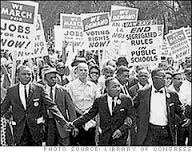 On August 29, the New York Times carried another article which included the comments of one of the riders, Hazel Mangle Rivers, who had paid $8 for her ticket, “one-tenth of her husband’s weekly salary.” Rivers stated that she was impressed by Washington’s civility: “The people are lots better up here than they are down South. They treat you much nicer. Why, when I was out there at the march a white man stepped on my foot, and he said, “Excuse me,” and I said “Certainly!” That’s the first time that has ever happened to me. I believe that was the first time a white person has ever really been nice to me.”
On August 29, the New York Times carried another article which included the comments of one of the riders, Hazel Mangle Rivers, who had paid $8 for her ticket, “one-tenth of her husband’s weekly salary.” Rivers stated that she was impressed by Washington’s civility: “The people are lots better up here than they are down South. They treat you much nicer. Why, when I was out there at the march a white man stepped on my foot, and he said, “Excuse me,” and I said “Certainly!” That’s the first time that has ever happened to me. I believe that was the first time a white person has ever really been nice to me.”
The March
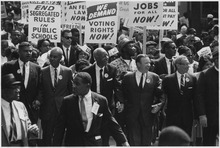 Leaders marching from the Washington Monument to the Lincoln Memorial
Leaders marching from the Washington Monument to the Lincoln Memorial
The march commanded national attention by preempting regularly scheduled television programs. As the first ceremony of such magnitude ever initiated and dominated by African Americans, the march also was the first to have its nature wholly misperceived in advance. Dominant expectations ran from paternal apprehension to dread. On Meet the Press, reporters grilled Roy Wilkins and Martin Luther King about widespread foreboding that “it would be impossible to bring more than 100,000 militant Negroes into Washington without incidents and possibly rioting.” Life magazine declared that the capital was suffering “its worst case of invasion jitters since the First Battle of Bull Run.” The Pentagon readied nineteen thousand troops in the suburbs and the jails shifted inmates to other prisons to make room for those arrested in mass arrests; the city banned all sales of alcoholic beverages; hospitals made room for riot casualties by postponing elective surgery. With nearly 1,700 extra correspondents supplementing the Washington press corps, the march drew a media assembly larger than the Kennedy inauguration two years earlier.
On August 28, more than 2,000 buses, 21 chartered trains, 10 chartered airliners, and uncounted cars converged on Washington. All regularly scheduled planes, trains, and buses were also filled to capacity.
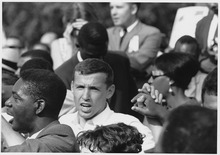 Nearly 250,000 people marched, including 60,00 white participants
Nearly 250,000 people marched, including 60,00 white participants
The march began at the Washington Monument and ended at the Lincoln Memorial with a program of music and speakers. The march failed to start on time because its leaders were meeting with members of Congress. To the leaders’ surprise, the assembled group began to march from the Washington Monument to the Lincoln Memorial without them.
The 1963 March also spurred anniversary marches that occur every five years, with the 20th and 25th being some of the most well known. The 25th Anniversary theme was “We Still have a Dream…Jobs*Peace*Freedom.”
Speakers
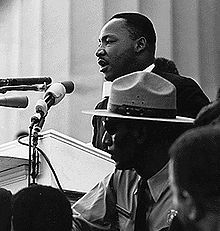 Martin Luther King, Jr. delivering his “I Have a Dream” speech
Martin Luther King, Jr. delivering his “I Have a Dream” speech
Representatives from each of the sponsoring organizations addressed the crowd from the podium at the Lincoln Memorial. Speakers included The Big Six; Catholic, Protestant, and Jewish religious leaders; and labor leader Walter Reuther. None of the official speeches were by women; Josephine Baker gave a speech during the preliminary offerings, but women’s presence in the official program was limited to a “tribute” led by Bayard Rustin (planned to be Myrlie Evers, who was unable to attend due to a prior commitment in Boston).
Floyd McKissick read James Farmer’s speech because Farmer had been arrested during a protest in Louisiana; Farmer had written that the protests would not stop “until the dogs stop biting us in the South and the rats stop biting us in the North.”
Official program
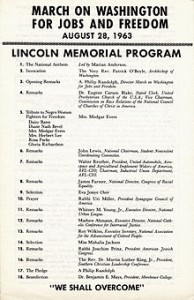 March on Washington for Jobs and Freedom program
March on Washington for Jobs and Freedom program
Marian Anderson was scheduled to lead theNational Anthem but was unable to arrive on time; Camilla Williams performed in her place. Following an invocation by Archbishop Patrick O’Boyle, the opening remarks were given by march director A. Philip Randolph, followed by Eugene Carson Blake. A tribute to “Negro Women Fighters for Freedom” was then led by Bayard Rustin (substituting for the absent Myrlie Evers), who introduced Daisy Bates, Diane Nash, Prince E. Lee, Rosa Parks, and Gloria Richardson. The following speakers were SNCC chairman John Lewis, labor leader Walter Reuther and CORE chairman Floyd McKissick (substituting for arrested CORE director James Farmer). The Eva Jessye Choir then sang, and Rabbi Uri Miller (president of the Synagogue Council of America) offered a prayer, followed by National Urban League director Whitney Young, NCCIJ director Mathew Ahmann, and NAACP leader Roy Wilkins. After a performance by singer Mahalia Jackson, American Jewish Congress president Joachim Prinz spoke, followed by SCLC president Martin Luther King, Jr. Rustin then read the march’s official demands for the crowd’s approval, and Randolph led the crowd in a pledge to continue working for the march’s goals. The program was closed with a benediction by Morehouse College president Benjamin Mays.
Although one of the officially stated purposes of the march was to support the civil rights bill introduced by the Kennedy Administration, several of the speakers criticized the proposed law as insufficient.

James Baldwin in 1971
Author James Baldwin was prevented from speaking at the March on the grounds that his comments would be too inflammatory. Baldwin later commented on the irony of the “terrifying and profound” requests that he prevent the March from happening:
“In my view, by that time, there was, on the one hand, nothing to prevent—the March had already been co-opted—and, on the other, no way of stopping the people from descending on Washington. What struck me most horribly was that virtually no one in power (including some blacks or Negroes who were somewhere next door to power) was able, even remotely, to accept the depth, the dimension, of the passion and the faith of the people.”
Controversy over John Lewis’ speech
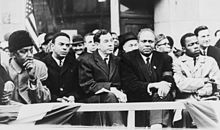
Lewis (far right) with Bayard Rustin, Andrew Young, William Fitts Ryan, and James L. Farmer, Jr.
John Lewis of SNCC was the youngest speaker at the event. His speech—which a number of SNCC activists had helped write—took the Administration to task for how little it had done to protect southern blacks and civil rights workers under attack in the Deep South. Cut from his original speech at the insistence of more conservative and pro-Kennedy leaders were phrases such as:
“In good conscience, we cannot support wholeheartedly the administration’s civil rights bill, for it is too little and too late. … I want to know, which side is the federal government on?… The revolution is a serious one. Mr. Kennedy is trying to take the revolution out of the streets and put it into the courts. Listen, Mr. Kennedy. Listen, Mr. Congressman. Listen, fellow citizens. The black masses are on the march for jobs and freedom, and we must say to the politicians that there won’t be a “cooling-off” period….We will march through the South, through the heart of Dixie, the way Sherman did. We shall pursue our own scorched earth policy and burn Jim Crow to the ground—nonviolently…”
Many activists from SNCC, CORE, and even SCLC were angry at what they considered censorship of his speech.
 Martin Luther King, Jr.’s speech: I Have a Dream
Martin Luther King, Jr.’s speech: I Have a Dream
The speech given by SCLC president King, who spoke last, became known as the “I Have a Dream” speech, which was carried live by TV stations and subsequently considered the most impressive moment of the march. Over time it has been hailed as a masterpiece of rhetoric, added to the National Recording Registry and memorialized by the National Park Service with an inscription on the spot where King stood to deliver the speech.
Singers

Marian Anderson in 1940, by Carl Van Vechten

Anderson in her 1939 concert at the Lincoln Memorial
Gospel legend Mahalia Jackson sang “How I Got Over“, and Marian Anderson sang “He’s Got the Whole World in His Hands“. This was not Marian Anderson’s first appearance at the Lincoln Memorial. In 1939, the Daughters of the American Revolution refused permission for Anderson to sing to an integrated audience in Constitution Hall. With the aid of First Lady Eleanor Roosevelt and her husband Franklin D. Roosevelt, Anderson performed a critically acclaimed open-air concert on Easter Sunday, 1939, on the steps of the Lincoln Memorial.
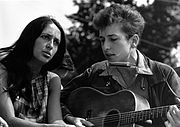 Joan Baez and Bob Dylan performing at the March
Joan Baez and Bob Dylan performing at the March
Musician Bob Dylan performed several songs, including “Only a Pawn in Their Game“, about the culturally fed racial hatred amongst Southern whites that led to the assassination of Medgar Evers; and “When the Ship Comes In“, during which he was joined by fellow folk singer Joan Baez, who earlier had led the crowds in several verses of “We Shall Overcome” and “Oh Freedom“. Peter, Paul and Mary sang “If I Had a Hammer” and Dylan’s “Blowin’ in the Wind.” Odetta sang “I’m On My Way.”
Media coverage
Media attention gave the march national exposure, carrying the organizers’ speeches and offering their own commentary. In his section The March on Washington and Television News, William Thomas notes: “Over five hundred cameramen, technicians, and correspondents from the major networks were set to cover the event. More cameras would be set up than had filmed the last Presidential inauguration. One camera was positioned high in the Washington Monument, to give dramatic vistas of the marchers.”
Criticism
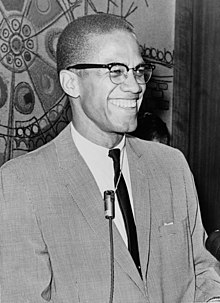
Malcolm X
Black nationalist Malcolm X, in his Message to the Grass Roots speech, criticized the march, describing it as “a picnic” and “a circus”. He said the civil rights leaders had diluted the original purpose of the march, which had been to show the strength and anger of black people, by allowing white people and organizations to help plan and participate in the march.
http://en.wikipedia.org/wiki/March_on_Washington_for_Jobs_and_Freedom

